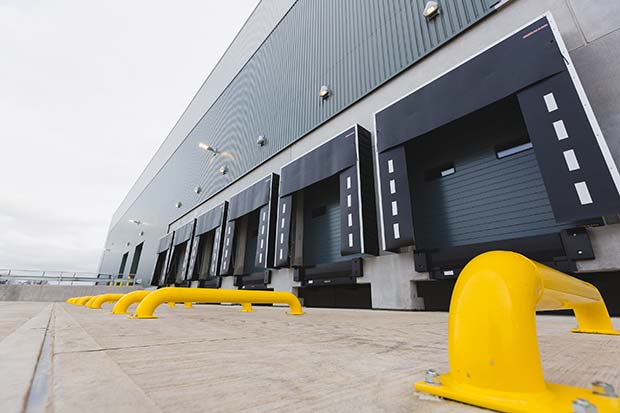The design of warehouses and the specification of loading technologies continues to evolve and support the supply chain operators in successfully meeting the increasing demands placed on the logistics sector. With the current climate presenting the industry with one of its toughest challenges to date, Phil Thorpe, Industrial Division Manager at Hörmann UK, shares his insight into the latest innovations being developed and the importance of regular servicing.
 Research by the Office of National Statistics shows that online sales reached a record high of 22.3% in the UK throughout March 2020, as consumers purchasing habits shifted online due to the Coronavirus lockdown and have continue to grow month on month.
Research by the Office of National Statistics shows that online sales reached a record high of 22.3% in the UK throughout March 2020, as consumers purchasing habits shifted online due to the Coronavirus lockdown and have continue to grow month on month.
As the internet continues to take a larger share of the retail sector, supply chain operators are not only having to facilitate the successful transition of their traditional intake of orders, but also assist with “last mile” deliveries.
The increasing pressure to ensure the delivery of all types and sizes of products is creating additional issues relating to the nature of warehouse design. Potential occupiers require multi-faceted warehousing hubs that incorporate a diverse offering of technologies to help them not only meet the consumer demand of today, but the expectations of the future.
Historically, swing lip dock levellers were commonplace in warehouses, as only larger fleets were catered for. However, in today’s fast-paced e-commerce environment, landlords, together with end users, are looking to specify new technologies to streamline processes and improve operational output.
For example, longer telescopic lip dock levellers have become a common addition as the need for flexibility of offloading various vehicle types on a single loading bay increase.
These include additional leveller options, such as increased lip projection and split lips that are suitable for standard trailers sizes, double deck vehicles and right down to smaller vans for loading and unloading.
The addition of dock shelters designed specifically for van type vehicles, such as Mercedes Sprinters, are also becoming more prevalent across warehousing sites, as supply chain operators look to cater for “last mile” deliveries.
As double deck trucks continue to become commonplace throughout the supply chain, the installation of double deck dock shelters within a warehouse enables clients to transport goods in and out using larger trucks, as well as standard sized heavy goods vehicles. This provides optimum operational efficiency, whilst offering enhanced thermal performance, as the double deck dock shelters are fitted with secondary electric roller blind top flaps to provide an efficient seal on smaller vehicles when using the bay.
Inflatable dock shelters are also increasing in popularity as landlords look to minimise heat transfer during the loading and unloading process, whilst improving the level of safety with which professionals operate within. By specifying a range of bay types throughout the construction of a warehousing unit prior to the occupation of a specific end user, it enables the developer to widen its potential client base as it can easily and sufficiently support a diverse vehicle fleet.
Whilst the types of technologies being specified throughout warehouses are adapting in order to successfully facilitate demand, the level of servicing, and how it is delivered, is also evolving. Manufacturing downtime costs British manufacturers more than £180 billion a year due to lost productivity. With the recent boom in e-commerce demand, it’s crucial to a business’ success and bottom line that their loading bays are fully operational at all times.
Minimising the risk of damage to goods, and most importantly, reducing the risk of injury to employees and external staff, can initially be achieved through the installation of safe and innovative solutions. However, this must be supported through regular servicing.
Whilst all loading technology must comply to EN Safety Standards: EN1398, manufacturers of loading bays and dock levellers, along with the company or building owner, have a shared level of responsibility to ensure the loading area is working correctly and efficiently. The Safety At Work Regulations do not dictate a set number of times a loading bay must be serviced, however, it is recommended all loading technology is serviced at least twice a year.
For regular bi-annum servicing, professionals should complete a comprehensive check regime. By analysing between 30 – 40 different areas, the engineer can confidentially ensure each aspect of the system is functioning correctly and safely.
Whilst availability of engineers is key to ensure a warehouse is back up and running as quickly as possible, this must be supported by a first time fix ratio where the servicing team keeps maintenance consumables on their van, whilst the warehousing site has a critical spares holding. This can significantly increase the responsiveness of the repair, as the most vital and cumbersome parts are already on site and do not have to be externally ordered in.
As consumers’ expectations of e-commerce are heightened, the industry must continue to adopt an alternative approach to the types of technologies being specified and installed throughout warehousing hubs. This will not only ensure the increased level of demand is met, but guarantee it is achieved in a safe, secure and efficient manner.
For further information on Hörmann UK’s servicing department and loading technology, call 01530 516850 or visit: www.hormann.co.uk/industry-commerce-and-public-authorities




Comments are closed.